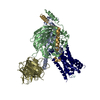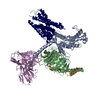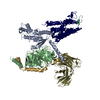+ データを開く
データを開く
- 基本情報
基本情報
| 登録情報 | データベース: PDB / ID: 8jgg | |||||||||
|---|---|---|---|---|---|---|---|---|---|---|
| タイトル | CryoEM structure of Gi-coupled MRGPRX1 with peptide agonist BAM8-22 | |||||||||
 要素 要素 |
| |||||||||
 キーワード キーワード | STRUCTURAL PROTEIN / itch receptor / Mas-related GPCRs / MRGPRX1 | |||||||||
| 機能・相同性 |  機能・相同性情報 機能・相同性情報synaptic vesicle lumen / response to chloroquine / chromaffin granule lumen / opioid peptide activity / aggressive behavior / general adaptation syndrome, behavioral process / positive regulation of behavioral fear response / symmetric synapse / neuronal dense core vesicle lumen / synaptic signaling via neuropeptide ...synaptic vesicle lumen / response to chloroquine / chromaffin granule lumen / opioid peptide activity / aggressive behavior / general adaptation syndrome, behavioral process / positive regulation of behavioral fear response / symmetric synapse / neuronal dense core vesicle lumen / synaptic signaling via neuropeptide / response to epinephrine / G protein-coupled opioid receptor signaling pathway / cell body fiber / cellular response to vitamin D / sensory perception / neuropeptide hormone activity / startle response / transmission of nerve impulse / response to immobilization stress / locomotory exploration behavior / neuropeptide signaling pathway / behavioral fear response / cellular response to transforming growth factor beta stimulus / adenylate cyclase inhibitor activity / glial cell proliferation / positive regulation of protein localization to cell cortex / Adenylate cyclase inhibitory pathway / T cell migration / D2 dopamine receptor binding / response to prostaglandin E / adenylate cyclase regulator activity / G protein-coupled serotonin receptor binding / adenylate cyclase-inhibiting serotonin receptor signaling pathway / axon terminus / sensory perception of pain / cellular response to forskolin / regulation of mitotic spindle organization / Peptide ligand-binding receptors / cellular response to cAMP / acute-phase response / response to nicotine / Post-translational protein phosphorylation / Regulation of insulin secretion / positive regulation of cholesterol biosynthetic process / negative regulation of insulin secretion / G protein-coupled receptor binding / G protein-coupled receptor activity / response to peptide hormone / adenylate cyclase-inhibiting G protein-coupled receptor signaling pathway / response to calcium ion / cellular response to virus / adenylate cyclase-modulating G protein-coupled receptor signaling pathway / response to toxic substance / G-protein beta/gamma-subunit complex binding / centriolar satellite / Olfactory Signaling Pathway / Activation of the phototransduction cascade / G beta:gamma signalling through PLC beta / Presynaptic function of Kainate receptors / Thromboxane signalling through TP receptor / G protein-coupled acetylcholine receptor signaling pathway / Regulation of Insulin-like Growth Factor (IGF) transport and uptake by Insulin-like Growth Factor Binding Proteins (IGFBPs) / G-protein activation / Activation of G protein gated Potassium channels / Inhibition of voltage gated Ca2+ channels via Gbeta/gamma subunits / Prostacyclin signalling through prostacyclin receptor / G beta:gamma signalling through CDC42 / Glucagon signaling in metabolic regulation / G beta:gamma signalling through BTK / Synthesis, secretion, and inactivation of Glucagon-like Peptide-1 (GLP-1) / ADP signalling through P2Y purinoceptor 12 / photoreceptor disc membrane / Sensory perception of sweet, bitter, and umami (glutamate) taste / Glucagon-type ligand receptors / Adrenaline,noradrenaline inhibits insulin secretion / osteoblast differentiation / Vasopressin regulates renal water homeostasis via Aquaporins / GDP binding / Glucagon-like Peptide-1 (GLP1) regulates insulin secretion / G alpha (z) signalling events / cellular response to catecholamine stimulus / ADP signalling through P2Y purinoceptor 1 / ADORA2B mediated anti-inflammatory cytokines production / G beta:gamma signalling through PI3Kgamma / Cooperation of PDCL (PhLP1) and TRiC/CCT in G-protein beta folding / adenylate cyclase-activating dopamine receptor signaling pathway / transmembrane signaling receptor activity / GPER1 signaling / Inactivation, recovery and regulation of the phototransduction cascade / cellular response to prostaglandin E stimulus / response to estradiol / G-protein beta-subunit binding / heterotrimeric G-protein complex / G alpha (12/13) signalling events / sensory perception of taste / extracellular vesicle / signaling receptor complex adaptor activity / Thrombin signalling through proteinase activated receptors (PARs) / retina development in camera-type eye / G protein activity 類似検索 - 分子機能 | |||||||||
| 生物種 |  Homo sapiens (ヒト) Homo sapiens (ヒト) | |||||||||
| 手法 | 電子顕微鏡法 / 単粒子再構成法 / クライオ電子顕微鏡法 / 解像度: 3 Å | |||||||||
 データ登録者 データ登録者 | Sun, J.P. / Xu, H.E. / Ynag, F. / Liu, Z.M. / Guo, L.L. / Zhang, Y.M. / Fang, G.X. / Tie, L. / Zhuang, Y.M. / Xue, C.Y. | |||||||||
| 資金援助 |  中国, 2件 中国, 2件
| |||||||||
 引用 引用 |  ジャーナル: Nat Commun / 年: 2023 ジャーナル: Nat Commun / 年: 2023タイトル: Ligand recognition and G protein coupling of the human itch receptor MRGPRX1. 著者: Lulu Guo / Yumu Zhang / Guoxing Fang / Lu Tie / Yuming Zhuang / Chenyang Xue / Qi Liu / Minghui Zhang / Kongkai Zhu / Chongzhao You / Peiyu Xu / Qingning Yuan / Chao Zhang / Lei Liu / Naikang ...著者: Lulu Guo / Yumu Zhang / Guoxing Fang / Lu Tie / Yuming Zhuang / Chenyang Xue / Qi Liu / Minghui Zhang / Kongkai Zhu / Chongzhao You / Peiyu Xu / Qingning Yuan / Chao Zhang / Lei Liu / Naikang Rong / Shengxuan Peng / Yuan Liu / Chuanzheng Wang / Xin Luo / Zongyao Lv / Dongwei Kang / Xiao Yu / Cheng Zhang / Yi Jiang / Xinzhong Dong / Jiuyao Zhou / Zhongmin Liu / Fan Yang / H Eric Xu / Jin-Peng Sun /   要旨: MRGPRX1, a Mas-related GPCR (MRGPR), is a key receptor for itch perception and targeting MRGPRX1 may have potential to treat both chronic itch and pain. Here we report cryo-EM structures of the ...MRGPRX1, a Mas-related GPCR (MRGPR), is a key receptor for itch perception and targeting MRGPRX1 may have potential to treat both chronic itch and pain. Here we report cryo-EM structures of the MRGPRX1-Gi1 and MRGPRX1-Gq trimers in complex with two peptide ligands, BAM8-22 and CNF-Tx2. These structures reveal a shallow orthosteric pocket and its conformational plasticity for sensing multiple different peptidic itch allergens. Distinct from MRGPRX2, MRGPRX1 contains a unique pocket feature at the extracellular ends of TM3 and TM4 to accommodate the peptide C-terminal "RF/RY" motif, which could serve as key mechanisms for peptidic allergen recognition. Below the ligand binding pocket, the GXPFGXF/W motif is essential for the inward tilting of the upper end of TM6 to induce receptor activation. Moreover, structural features inside the ligand pocket and on the cytoplasmic side of MRGPRX1 are identified as key elements for both Gi and Gq signaling. Collectively, our studies provide structural insights into understanding itch sensation, MRGPRX1 activation, and downstream G protein signaling. | |||||||||
| 履歴 |
|
- 構造の表示
構造の表示
| 構造ビューア | 分子:  Molmil Molmil Jmol/JSmol Jmol/JSmol |
|---|
- ダウンロードとリンク
ダウンロードとリンク
- ダウンロード
ダウンロード
| PDBx/mmCIF形式 |  8jgg.cif.gz 8jgg.cif.gz | 220.6 KB | 表示 |  PDBx/mmCIF形式 PDBx/mmCIF形式 |
|---|---|---|---|---|
| PDB形式 |  pdb8jgg.ent.gz pdb8jgg.ent.gz | 165.9 KB | 表示 |  PDB形式 PDB形式 |
| PDBx/mmJSON形式 |  8jgg.json.gz 8jgg.json.gz | ツリー表示 |  PDBx/mmJSON形式 PDBx/mmJSON形式 | |
| その他 |  その他のダウンロード その他のダウンロード |
-検証レポート
| 文書・要旨 |  8jgg_validation.pdf.gz 8jgg_validation.pdf.gz | 1.2 MB | 表示 |  wwPDB検証レポート wwPDB検証レポート |
|---|---|---|---|---|
| 文書・詳細版 |  8jgg_full_validation.pdf.gz 8jgg_full_validation.pdf.gz | 1.2 MB | 表示 | |
| XML形式データ |  8jgg_validation.xml.gz 8jgg_validation.xml.gz | 39.4 KB | 表示 | |
| CIF形式データ |  8jgg_validation.cif.gz 8jgg_validation.cif.gz | 58.2 KB | 表示 | |
| アーカイブディレクトリ |  https://data.pdbj.org/pub/pdb/validation_reports/jg/8jgg https://data.pdbj.org/pub/pdb/validation_reports/jg/8jgg ftp://data.pdbj.org/pub/pdb/validation_reports/jg/8jgg ftp://data.pdbj.org/pub/pdb/validation_reports/jg/8jgg | HTTPS FTP |
-関連構造データ
| 関連構造データ |  36233MC  8jgbC  8jgfC M: このデータのモデリングに利用したマップデータ C: 同じ文献を引用 ( |
|---|---|
| 類似構造データ | 類似検索 - 機能・相同性  F&H 検索 F&H 検索 |
- リンク
リンク
- 集合体
集合体
| 登録構造単位 | 
|
|---|---|
| 1 |
|
- 要素
要素
-Guanine nucleotide-binding protein ... , 3種, 3分子 GAB
| #1: タンパク質 | 分子量: 6633.625 Da / 分子数: 1 / 由来タイプ: 組換発現 / 由来: (組換発現)  Homo sapiens (ヒト) / 遺伝子: GNG2 Homo sapiens (ヒト) / 遺伝子: GNG2発現宿主:  参照: UniProt: P59768 |
|---|---|
| #4: タンパク質 | 分子量: 40415.031 Da / 分子数: 1 / 由来タイプ: 組換発現 / 由来: (組換発現)  Homo sapiens (ヒト) / 遺伝子: GNAI1 Homo sapiens (ヒト) / 遺伝子: GNAI1発現宿主:  参照: UniProt: P63096 |
| #5: タンパク質 | 分子量: 38561.152 Da / 分子数: 1 / 由来タイプ: 組換発現 / 由来: (組換発現)  Homo sapiens (ヒト) / 遺伝子: GNB1 Homo sapiens (ヒト) / 遺伝子: GNB1発現宿主:  参照: UniProt: P62873 |
-タンパク質・ペプチド / 抗体 / タンパク質 , 3種, 3分子 LSR
| #2: タンパク質・ペプチド | 分子量: 1603.797 Da / 分子数: 1 / 由来タイプ: 合成 / 由来: (合成)  Homo sapiens (ヒト) / 参照: UniProt: P01210 Homo sapiens (ヒト) / 参照: UniProt: P01210 |
|---|---|
| #3: 抗体 | 分子量: 30363.043 Da / 分子数: 1 / 由来タイプ: 組換発現 / 由来: (組換発現)  Homo sapiens (ヒト) Homo sapiens (ヒト)発現宿主:  |
| #6: タンパク質 | 分子量: 36276.906 Da / 分子数: 1 / 由来タイプ: 組換発現 / 由来: (組換発現)  Homo sapiens (ヒト) / 遺伝子: MRGPRX1, MRGX1, SNSR3, SNSR4 Homo sapiens (ヒト) / 遺伝子: MRGPRX1, MRGX1, SNSR3, SNSR4発現宿主:  参照: UniProt: Q96LB2 |
-詳細
| Has protein modification | Y |
|---|
-実験情報
-実験
| 実験 | 手法: 電子顕微鏡法 |
|---|---|
| EM実験 | 試料の集合状態: PARTICLE / 3次元再構成法: 単粒子再構成法 |
- 試料調製
試料調製
| 構成要素 | 名称: CryoEM structure of Gi-coupled MRGPRX1 with peptide agonist BAM8-22 タイプ: COMPLEX / Entity ID: all / 由来: RECOMBINANT |
|---|---|
| 由来(天然) | 生物種:  Homo sapiens (ヒト) Homo sapiens (ヒト) |
| 由来(組換発現) | 生物種:  |
| 緩衝液 | pH: 7.5 |
| 試料 | 包埋: NO / シャドウイング: NO / 染色: NO / 凍結: YES |
| 急速凍結 | 凍結剤: ETHANE |
- 電子顕微鏡撮影
電子顕微鏡撮影
| 実験機器 |  モデル: Titan Krios / 画像提供: FEI Company |
|---|---|
| 顕微鏡 | モデル: FEI TITAN KRIOS |
| 電子銃 | 電子線源:  FIELD EMISSION GUN / 加速電圧: 300 kV / 照射モード: FLOOD BEAM FIELD EMISSION GUN / 加速電圧: 300 kV / 照射モード: FLOOD BEAM |
| 電子レンズ | モード: DIFFRACTION / 最大 デフォーカス(公称値): 1200 nm / 最小 デフォーカス(公称値): 800 nm |
| 撮影 | 電子線照射量: 60 e/Å2 / フィルム・検出器のモデル: GATAN K3 (6k x 4k) |
- 解析
解析
| CTF補正 | タイプ: PHASE FLIPPING AND AMPLITUDE CORRECTION |
|---|---|
| 3次元再構成 | 解像度: 3 Å / 解像度の算出法: FSC 0.143 CUT-OFF / 粒子像の数: 924644 / 対称性のタイプ: POINT |
 ムービー
ムービー コントローラー
コントローラー





 PDBj
PDBj































